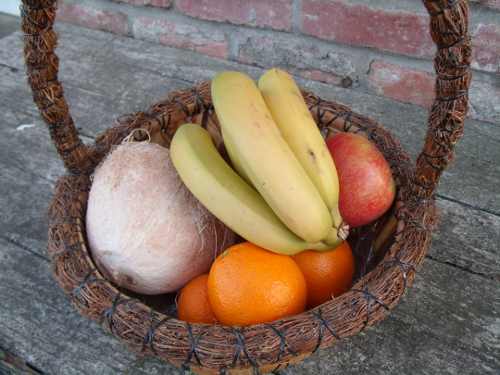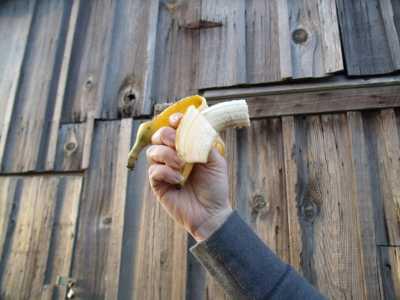
If you think Americans consume a lot of bananas – more than 26 pounds per person per year – try living in Uganda, where the average person consumes more than 500 pounds of the creamy fruit!
They’re beloved worldwide, which is reflected in their ranking among agricultural crops: fourth in global production, behind only wheat, rice and corn.
There are two distinct species of bananas: the sweet, which is usually eaten out of hand or in desserts, and the plantain, which is starchy and must be cooked prior to eating.
Plantains are typically treated more as a vegetable than a fruit and have a higher level of beta carotene than sweet bananas. They’ll be covered in a future column.
While bananas abound in hundreds of edible varieties, the banana most widely sold in supermarkets is the Cavendish.
In addition to the yellow skin of the Cavendish and the two or so other popular varieties, sweet bananas can sport red, pink, purple and black tones when ripe.
Red bananas, also known as “apple bananas,” are about four inches long and are becoming popular as an exotic variety.
Red bananas are greenish-maroon before ripening, but turn a beautiful shade of bronzy-red when ripe. They’re softer and sweeter than the typical banana and have a berry-like flavor component.
As well as varying in color, bananas come in a number of different sizes, including the miniature varieties now marketed in some areas. These have a tangy flavor when yellow and, like their larger cousins, become quite sweet when the skin speckles.
In a couple of ways, bananas are not quite what they seem.
First of all, botanically they’re not a fruit at all; they’re considered a berry.
Secondly, while the plant they grow on is called a tree (and is just as high), its trunk is a tightly-rolled bundle of leaves, making it the world’s largest herb.
I can add to this that bananas are – surprisingly – naturally radioactive, as are other foods high in potassium, such as potatoes, kidney beans, sunflower seeds and nuts. They contain large stores of potassium, specifically potassium-40, which is a radioactive isotope.
But don’t let that stop you from eating them. They’re perfectly healthy.
Bananas are thought to have originated in Malaysia about 4,000 years ago. From there, they spread throughout the Philippines and India, following later to Africa.
The Portuguese explorers who found bananas in Africa brought them to the Americas, where most of today’s commercial crop is grown.
The fruit wasn’t brought to the United States for sale until the latter part of the 19th century, and then they were only available in seaport towns where the banana schooners docked.
They became more widely available in the U.S. with the advent of refrigeration and rapid transit in the 20th century, leading to their status as our nation’s favorite fruit, with more bananas consumed here than oranges and apples combined.
Bananas, which grow in most tropical and subtropical regions throughout the world, are harvested year-round. They’re picked green since they don’t ripen on the tree.
If left on the tree, they’ll eventually split open, exposing a pulp which has a different texture and flavor than ripe bananas.
The bundles of harvested bananas are called hands, and the ten or twenty individual bananas in each hand is called a finger.
There are thousands of varieties of bananas, but most are unpalatable. Wild bananas are filled with large seeds, making them difficult to eat.
While commercial bananas do have seeds, they’re so small they’re unnoticeable. Their size also diminishes their function, meaning they’re not useful for the plant’s reproduction.
Most commercial banana plants are the Cavendish variety and are perfect clones of one another, with the majority originating from one single plant from Southeast Asia. This makes them extremely susceptible to being wiped out worldwide in a short period of time.
Currently, black Sigatoka fungus is threatening global banana crops, particularly on non-organic plantations where diseases and pests flourish without a rich diversity of soil life.
While bananas look resilient, they’re actually quite fragile and care should be taken when storing them.
Choose bananas based on how quickly you’ll use them. I prefer bananas firm, rather than overly ripe, so I almost always choose those that are green, knowing they’ll ripen up soon enough at home.
If you need to hasten the ripening process, place them in a paper bag or wrap them in newspaper. If an apple is added, they ripen even more quickly.
On the other hand, to slow this process down, allow air to circulate around them as much as possible, storing them on a banana hook or in a mesh container. Spread the bananas out to allow for maximum air flow.

Contrary to popular opinion, bananas can be stored in the fridge. The skin will darken – even turning black – but the flesh inside is protected.
Be cautious, however, about when you put them in there, making sure they are at the stage of ripeness you desire. Exposure to the cold will interrupt the ripening process, so much so that it likely will not resume once they’re pulled out.
If you find yourself with too many bananas on the express train to the overripe station, freezing is a great way to preserve them for future use.
I remove the peel and wrap each banana in waxed paper. I then store the individually wrapped bananas in a zipper-sealed bag in the freezer, where they should keep well for about six months.
These are absolutely wonderful for making smoothies thick, frosty and hearty. You can also cut the frozen bananas up to blend with plain yogurt for a naturally sweet, ice cream-like treat.
They’re perfect for your favorite banana bread or muffin recipe, as well as any other application where bananas are used mashed.
If you’re lucky enough to get your hands on fresh banana leaves, use them to wrap foods for steaming. Fresh fish is especially nice when prepared this way.
Bananas are one of our best sources of dietary potassium, which supports cardiovascular health, lowers blood pressure and prevents muscle cramps.
Bananas replenish necessary nutrients burned during physical exercise, such as glycogen, body fluids and carbohydrates.
In addition to potassium, they’re a great source of dietary fiber, vitamin B6, manganese and vitamin C, and they’ve been shown to help prevent stomach ulcers.
As to today’s recipe, I searched high and low to find a savory application for bananas that didn’t involve deep frying, and I came close with the sweet potato dish below.
Bananas, sweet potatoes, spices and nuts are a wonderful combination, and though the recipe contains some butter, it’s otherwise a healthful one.
The original recipe calls for pecans, but I substituted walnuts. Not only are they more economical, they’re delicious and abundant in Lake County.
And before I go, if you’re feeling down, it turns out that eating a banana may be just the ticket for elevating one’s mood.
It’s the only fruit that contains both tryptophan (an amino acid) and vitamin B6, a combination which helps the body produce serotonin, a natural chemical thought to contribute to feelings of well being and happiness.
Who would have thought that a simple banana could give Prozac a run for its money?
Sweet potato puree with bananas and buttered walnuts
6 pounds (about 6) sweet potatoes
2 ripe bananas, skins on
2 ounces (1/2 stick) unsalted butter, softened
½ cup pure maple syrup
2 tablespoons ground cinnamon
2 teaspoons pumpkin pie spice
½ teaspoon salt
For the buttered walnuts
1 pound walnuts
½ cup unsalted butter
About 1 tablespoon salt
2 tablespoons brown sugar
Preheat oven to 425 degrees Fahrenheit.
Pierce the sweet potatoes with a fork and bake until tender, about one hour. Roast the bananas, with the skins on, for the last 15 minutes of cooking. When cool enough to handle, peel the potatoes and bananas and transfer to a food processor. Pulse until the potatoes are chunky.
Add the butter and maple syrup, puree until smooth. Add the cinnamon, pumpkin pie spice and salt. Puree to combine. Transfer to a shallow baking pan and smooth out the surface with a spatula.
In a skillet, cook the nuts in butter over low heat and sprinkle with salt. Sauté until well-coated, stirring occasionally, for about five minutes. Transfer the nuts to paper towels to drain.
Arrange nuts on top of potato puree and sprinkle with brown sugar. Bake at 300 degrees Fahrenheit until heated through, about 20 minutes.
This recipe makes six to eight servings and its inspiration is courtesy of www.FoodNetwork.com.
Esther’s note: Pumpkin pie spice is a combination of cinnamon, ginger, cloves, nutmeg and occasionally allspice. If it’s not already in your cupboard, you can make a homemade version by combining 1 teaspoon ground cinnamon, ½ teaspoon each ground ginger and nutmeg, and ¼ teaspoon ground cloves to substitute for the 2 teaspoons of pumpkin pie spice.
Esther Oertel, a freelance writer, cooking teacher, and speaker, is passionate about local produce and all foods in the vegetable kingdom. She welcomes your questions and comments and may be reached at This email address is being protected from spambots. You need JavaScript enabled to view it..
Follow Lake County News on Twitter at http://twitter.com/LakeCoNews, on Tumblr at www.lakeconews.tumblr.com, on Google+, on Facebook at www.facebook.com/pages/Lake-County-News/143156775604?ref=mf and on YouTube at www.youtube.com/user/LakeCoNews .

 How to resolve AdBlock issue?
How to resolve AdBlock issue? 





